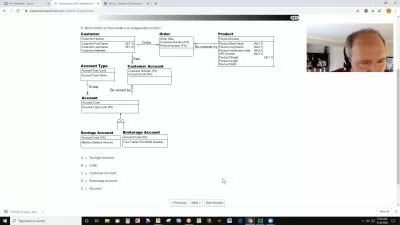Essential Code for Data-Science Projects COMPLETE COURSE
Focused View
13:11:23
14 View
1. Installing the necessary software.mp4
04:00
1. 1. How to effectively read an xlsx file.mp4
08:25
2. Skip reading rows when reading a dataframe.mp4
04:11
3. How to read a specific sheet from an excel file.mp4
01:27
4. Set the index of a dataframe upon reading it.mp4
06:07
5. Read specific columns from an excel file.mp4
02:53
6. Read data from World Bank.mp4
09:40
7. Send many dataframes into the same Excel file.mp4
06:37
8. Send a dataframe to a CSV.mp4
02:00
9. Hide Warnings.mp4
04:25
10. Reading rows from topbottom (nrows, skipfooter).mp4
04:41
11. Check if an Excel cell is empty.mp4
09:52
12. Check the version of the installed packages.mp4
02:14
13. Hide special warnings.mp4
03:07
1. 1. Set and reset the index.mp4
16:55
2. Change the name of the index of a dataframe.mp4
02:09
3. Find the rowcolumn index of any element of a dataframe.mp4
11:20
4. The enumerate() command to enumerate rowselements.mp4
08:29
5. Sort the index of a dataframe sort index.mp4
02:19
1. How to sort the elements of a list.mp4
14:05
2. Remove elements from a list.mp4
04:42
3. Create a sublist from another list.mp4
08:06
4. List comprehension from consecutive numbers.mp4
05:53
5. Print first last elements of a list.mp4
00:56
6. Place in a list the elements of another list.mp4
01:44
7. Remove all occurrences of an element.mp4
05:08
8. pop() versus remove().mp4
04:36
9. List comprehensions.mp4
03:54
10. Slicing.mp4
06:41
11. Enumerate, index.mp4
05:45
12. series.isin(list).mp4
03:50
13. Count how many times an element is in a list.mp4
01:58
14. Make a copy and an alias of a list.mp4
01:09
1. Return elements from a dataframe.mp4
08:46
2. Delete rows columns (iloc, drop).mp4
05:51
3. Read indices and values of a dataframe.mp4
03:51
4. Show the max number of rowscolumns.mp4
03:17
5. Create a copy of a dataframe.mp4
01:58
6. Take a backup of a dataframe (copy versus =).mp4
04:45
7. Change specific values in a dataframe.mp4
07:09
8. Make a new column and fill it with the values of another column.mp4
02:10
9. Change the order of columns in a dataframe.mp4
07:36
10. New row and fill it with the values of other rows.mp4
04:13
11. New column with values 1,2,3... (arange).mp4
02:10
12. pivot tables.mp4
08:44
13. Rename rows columns of a dataframe.mp4
03:56
14. Use a dictionary to create a dataframe.mp4
03:25
15. Transpose of a dataframe.mp4
02:07
16. Select rowscolumns of a dataframe.mp4
08:17
17. Repeat a rowcolumn (np.repeat).mp4
10:51
18. Sorting the columns.mp4
07:52
19. Change the datatype of a rowcolumn (astype).mp4
04:25
20. Select specific rowscolumns (loc, arange).mp4
04:52
21. How to delete many rows from a dataframe.mp4
11:04
22. Get the value under another column of the same row.mp4
04:13
23. Use iteritems on a dataframe.mp4
03:39
24. Sort the values of a column (sort values).mp4
02:49
25. Populate a column via list, array, series.mp4
01:10
26. Define a dataframe with without a dictionary.mp4
02:15
27. Define a dataframe using list comprehension.mp4
00:58
1. Format the values of a dataframe to percentages.mp4
03:39
2. Format the elements of a dataframe to 1 decimal point.mp4
00:54
3. Apply a function to the elements of a series dataframe.mp4
01:31
1. Prevent data transfer from dataframe to dictionary.mp4
09:51
2. Prevent duplicate values in a dataframe.mp4
14:30
3. Prevent duplicate values while using True, Break.mp4
03:48
4. Break, continue, pass.mp4
07:16
5. For, else.mp4
05:41
6. While, For equivalence.mp4
02:12
7. While True.mp4
04:03
8. While , Else.mp4
02:29
1. How to define it.mp4
04:27
2. How to rename a column.mp4
02:30
3. How to remove a level.mp4
01:12
4. Print levels in a single cell (merge cells).mp4
03:26
5. From merged (dataframe) to unmerged (excel).mp4
07:15
6. How to implement iteritems.mp4
03:39
1. If, elif.mp4
02:55
2. inline if statement.mp4
05:47
3. Print statement with if-else embedded.mp4
02:29
1. AND, OR, FALSE, TRUE.mp4
02:18
2. NOT.mp4
02:33
3. The De Morgan Laws.mp4
06:15
4. Comparison of int, str, Float, Bool.mp4
06:11
5. Type conversions int , float, str, bool.mp4
10:03
6. Combining NOT with empty string lists.mp4
05:45
7. The meaning of x = None, [] , .mp4
01:11
8. Difference between is and =.mp4
04:25
1. Iterate via for-loop.mp4
02:56
2. Join two tuples.mp4
01:04
3. Define a tuple.mp4
02:07
4. Sort a tuple.mp4
02:30
5. Enumerate a tuple (enumerate, index).mp4
02:06
6. Find the frequency of elements (count).mp4
00:40
7. Tuple immutability.mp4
00:59
1. Remove NaN values by deleting rowscolumns.mp4
02:21
2. How to find if a dataframe has NaN values.mp4
03:43
3. Use min count to sum in presence of NaN values.mp4
05:32
4. Place NaN values in a dataframe , manually.mp4
02:22
5. Sum rows by ignoring NaN (skipna).mp4
02:24
6. Replace missing values with 0.mp4
01:46
1. Modelling VLOOKUP in Python.mp4
08:42
2. Modelling SUMIFS in Python.mp4
12:16
3. Modelling AVERAGEIFS in Python.mp4
06:00
1. Evaluate String expressions using eval().mp4
09:25
2. Remove trailing characters using rstrip, lstrip.mp4
04:04
3. Break a string in sets using wrap.mp4
03:13
4. Select part of a string.mp4
02:31
5. Remove white space using replace ().mp4
02:27
6. Search for multiple occurrences of a subtext.mp4
05:19
7. Select specific characters from a column using str.mp4
03:13
8. Replace a character or a word from inside a string.mp4
01:17
9. Unite strings from inside a list using join.mp4
00:56
10. Multiline strings .mp4
01:29
11. Formating strings and f-strings (format).mp4
08:18
12. Count how many times a character is inside a string.mp4
00:54
13. in, find() with strings.mp4
03:08
14. right-justify text using rjust.mp4
00:57
1. Using the function globals().mp4
03:37
2. Multiple assignment.mp4
02:39
3. Use global to change variables.mp4
08:57
1. Define a set, addremove elements.mp4
02:54
2. Convert a liststring to a set.mp4
01:33
3. Difference of two sets symmetric difference.mp4
10:48
4. Set comprehension.mp4
03:08
5. Subset, superset, proper subsetsuperset.mp4
03:37
6. Intersection and union.mp4
05:55
1. Edit strings inside series using. .str[].mp4
09:58
2. Create a series object of a constant value.mp4
03:31
3. Select a column as Series versus as a Dataframe.mp4
02:18
4. Broadcasting (saving) an array to a Series.mp4
03:03
1. Concatenate two arrays.mp4
02:07
2. linspace (equally spaced numbers).mp4
00:59
3. Reshaping the array.mp4
07:32
4. 1D, 2D, 3D arrays from lists.mp4
02:26
5. Modify elements of an array.mp4
02:01
6. Use arange to make 1D and 2D arrays.mp4
02:42
7. eye, ones, zeros.mp4
01:50
8. flattening an array.mp4
02:56
1. Docstring.mp4
02:14
2. Count how many times a function is called.mp4
05:02
3. How to return many values from a function.mp4
02:14
4. Default values for parameters.mp4
03:06
5. A function calling another function.mp4
01:49
1. Update a DateTimeIndex.mp4
05:00
2. The Workalendar package for Country dates.mp4
02:16
3. Timedelta() for time conversions.mp4
02:09
1. Use name .mp4
02:34
2. Check if the datatype is int float str NaN None.mp4
04:16
3. dtypes, astype() and the type of the dataframe elements.mp4
10:55
4. Converting elements of a column via astype.mp4
00:56
1. Define and loop through a dictionary.mp4
03:48
2. Find the number of elements in a dictionary.mp4
01:42
3. Convert to a listset of keysvalues.mp4
04:42
4. Convert a dataframe to a dictionary.mp4
07:28
5. Print the first 6 elements of a dictionary.mp4
03:51
6. What it means for x in dictionary.mp4
02:04
7. Convert a single value into a dictionary (keys).mp4
02:52
8. Avoid errors when a key is not found (get).mp4
17:27
9. Join two dictionaries ().mp4
04:14
10. Dictionary comprehension.mp4
01:46
11. Delete a key from a dictionary.mp4
00:26
12. Sort a dictionary.mp4
02:07
13. Mutability of a dictionary.mp4
00:53
1. Default dictionaries.mp4
12:14
1. Trigonometry, infinity, pi.mp4
02:31
2. regular division, integer division, modulo division, , %.mp4
03:36
3. dot product of 2 arrays.mp4
03:47
1. Try Except block.mp4
08:25
2. the finally statement.mp4
10:47
3. Raise errors based on user input.mp4
06:34
4. How to raise own errors.mp4
03:04
1. random choice.mp4
01:17
2. randint.mp4
00:53
3. randrange.mp4
00:55
4. random.random, random.seed.mp4
04:18
5. random.sample (sample without replacement).mp4
02:16
6. Fix the random seeds using a function.mp4
05:49
More details
User Reviews
Rating
average 0
Focused display
Category

Udemy
View courses UdemyStudents take courses primarily to improve job-related skills.Some courses generate credit toward technical certification. Udemy has made a special effort to attract corporate trainers seeking to create coursework for employees of their company.
- language english
- Training sessions 178
- duration 13:11:23
- Release Date 2023/12/04









